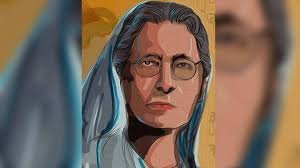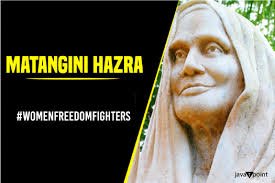The Legacy of Matangini Hazra: An Unsung Hero of Indian Independence
Introduction to Matangini Hazra
Matangini Hazra, often celebrated as one of the unsung heroes of India’s independence struggle, played a crucial role in the fight against British colonial rule. Her story is a testament to the courage and resilience exhibited by many freedom fighters who, despite their significant contributions, have remained largely unacknowledged in mainstream historical narratives.
Early Life and Background
Born on October 19, 1870, in the village of Hogla, West Bengal, Matangini Hazra emerged from a humble background. She was a member of the oppressed Dalit community, and her early life was marked by struggle and hardship. Despite these challenges, Hazra’s commitment to social justice and freedom grew stronger, setting the stage for her later activism.
Involvement in the Freedom Movement
Matangini Hazra’s involvement in the freedom movement began in the 1940s when she joined the Quit India Movement, which was a pivotal campaign launched by Mahatma Gandhi. She actively participated in protests and demonstrations against British rule. Hazra’s determination was evident as she led various rallies and was instrumental in mobilizing local communities to join the struggle for independence.
The Final Stand: The Pivotal Moment
On September 29, 1942, Hazra made a historic stand in the town of Tamluk, where she led a massive procession demanding the end of British rule. The British authorities, threatened by her leadership and the scale of the protest, responded with brutal force. Despite the violence and personal risk, Hazra continued to lead the procession, displaying extraordinary bravery. She was eventually shot and killed by British troops, becoming a martyr for the cause of Indian independence.
Recognition and Legacy
Matangini Hazra’s sacrifice was recognized posthumously, and she is remembered today as a symbol of unyielding courage and patriotism. Her contributions, though not widely acknowledged during her lifetime, have gained recognition in recent years. Schools, public places, and institutions have been named in her honor, reflecting the growing appreciation for her role in India’s freedom struggle.

Why This News is Important
Acknowledging Unsung Heroes
The story of Matangini Hazra is crucial for understanding the diverse contributions to India’s independence movement. While many freedom fighters are well-known, the recognition of figures like Hazra highlights the breadth of participation in the struggle for freedom. Her story underscores the importance of acknowledging all contributors, regardless of their background or the extent of their fame.
Inspiring Future Generations
Hazra’s life and sacrifice serve as a powerful inspiration for future generations. Her unwavering commitment and bravery in the face of adversity offer valuable lessons in perseverance and courage. By learning about her contributions, students and young leaders can draw motivation and inspiration to pursue their own goals and ideals with similar dedication.
Historical Accuracy and Inclusivity
Revisiting the stories of lesser-known figures in history ensures a more inclusive and accurate portrayal of historical events. Hazra’s story enriches the narrative of India’s struggle for independence, providing a more comprehensive understanding of the diverse individuals who played a role in shaping the nation.
Historical Context: Background Information
The Quit India Movement
The Quit India Movement, launched in August 1942, was a major campaign led by Mahatma Gandhi demanding an end to British rule in India. This movement marked a significant phase in India’s struggle for independence, characterized by mass protests and civil disobedience. It was during this movement that Matangini Hazra emerged as a prominent activist.
Social and Political Climate
The early 20th century in India was marked by increasing discontent against British colonial rule. Social reformers and political leaders were actively involved in various campaigns to challenge the colonial government’s policies and practices. The period also saw the rise of numerous grassroots activists who played crucial roles in mobilizing public opinion and organizing resistance.
Impact of World War II
World War II had a profound impact on the Indian independence movement. The global conflict intensified the demands for freedom, as many Indian leaders and activists saw the war as an opportunity to push for independence. The British government’s inability to address the growing unrest and the economic strains of the war further fueled the independence movement.
Key Takeaways from The Legacy of Matangini Hazra
| Serial Number | Key Takeaway |
|---|---|
| 1 | Matangini Hazra was a prominent figure in the Quit India Movement. |
| 2 | Born on October 19, 1870, she came from a humble background and belonged to the Dalit community. |
| 3 | She led a historic protest in Tamluk on September 29, 1942, and was martyred by British forces. |
| 4 | Hazra’s sacrifice is now recognized as a symbol of courage and patriotism in India’s freedom struggle. |
| 5 | Her story highlights the importance of acknowledging all contributors to historical movements. |
Important FAQs for Students from this News
1. Who was Matangini Hazra?
Matangini Hazra was an Indian freedom fighter and activist who played a significant role in the Quit India Movement. Born on October 19, 1870, she was known for her courageous leadership in anti-colonial protests against British rule.
2. What was the Quit India Movement?
The Quit India Movement, launched in August 1942 by Mahatma Gandhi, was a major campaign demanding an end to British rule in India. It was characterized by widespread civil disobedience and mass protests.
3. When and where did Matangini Hazra’s most notable protest take place?
Matangini Hazra led her most notable protest on September 29, 1942, in Tamluk, West Bengal. This protest was a significant part of the Quit India Movement.
4. What happened to Matangini Hazra during the Tamluk protest?
During the Tamluk protest, Hazra was leading a large procession when British troops fired upon the protesters. Despite the violence, she continued to lead the march and was eventually shot and killed, becoming a martyr for the independence cause.
5. Why is Matangini Hazra’s story important for students studying Indian history?
Matangini Hazra’s story is important because it highlights the contributions of lesser-known figures in India’s struggle for independence. Her bravery and sacrifice provide valuable lessons in perseverance and patriotism, enriching the historical understanding of the independence movement.
Some Important Current Affairs Links

















